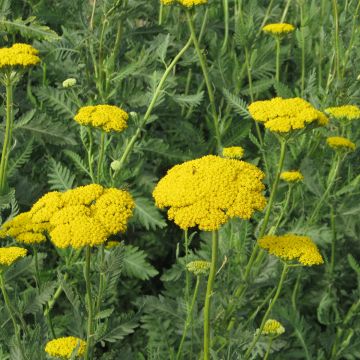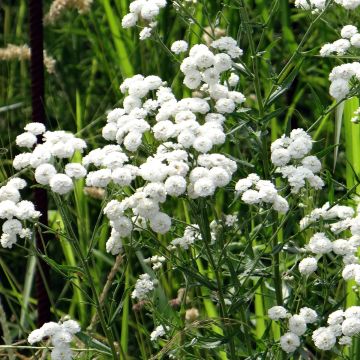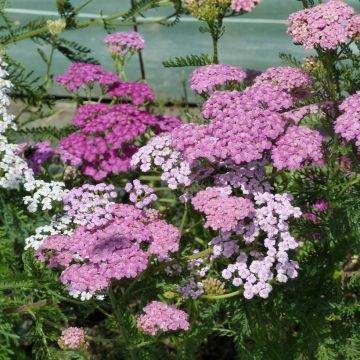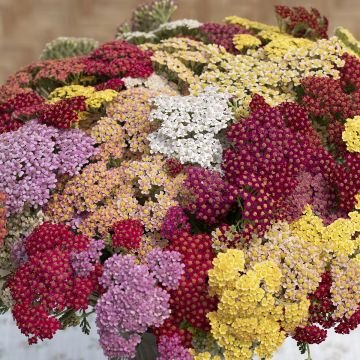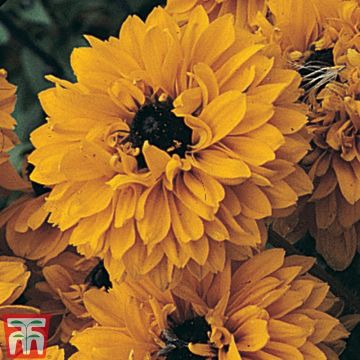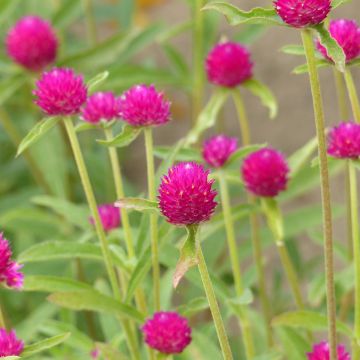

Achillea millefolium white - seeds
Achillea millefolium white - seeds
Achillea millefolium
Common Yarrow, Yarrow, Milfoil
Special offer!
Receive a €20 voucher for any order over €90 (excluding delivery costs, credit notes, and plastic-free options)!
1- Add your favorite plants to your cart.
2- Once you have reached €90, confirm your order (you can even choose the delivery date!).
3- As soon as your order is shipped, you will receive an email containing your voucher code, valid for 3 months (90 days).
Your voucher is unique and can only be used once, for any order with a minimum value of €20, excluding delivery costs.
Can be combined with other current offers, non-divisible and non-refundable.
Home or relay delivery (depending on size and destination)
Schedule delivery date,
and select date in basket
This plant carries a 6 months recovery warranty
More information
We guarantee the quality of our plants for a full growing cycle, and will replace at our expense any plant that fails to recover under normal climatic and planting conditions.
Would this plant suit my garden?
Set up your Plantfit profile →
Description
Achillea millefolium, commonly known as Yarrow, is a wild plant with white flowers. It is a vigorous perennial plant with light flowering in small corymbs. Its feathery, matte silver-green foliage, is intensely fragrant even when dried. It forms a tall, light and abundant, deciduous or semi-evergreen tuft. From July to September, this very undemanding perennial accompanies summer flowers in sunny and well-drained soil.
Yarrow belongs to the Asteraceae family, native to Europe and Asia Minor. It is a stoloniferous, perennial plant with evergreen leaves and an upright tufted habit from spring onwards. The plant reaches a height of 75 cm when in flower, 20 to 25 cm for the foliage. It spreads over 30 cm and more. The inflorescence is a flat-topped corymb. The remarkably long flowering period extends from June to October. The flower heads have tubular, pale yellow disc florets, while the peripheral florets are ligulate and white. These heads, which appear at the tops of the stems, form flat or slightly rounded corymbs, 7 cm in diameter. They are followed by fruits called achenes. The stem is ridged and hairy. The foliage is deciduous or semi-evergreen, very aromatic even when dried, and finely divided into strips. The leaves are feathery and dark green with silvery highlights.
Yarrow is an edible and medicinal wild plant. It does not have a particularly interesting taste, but it has many properties and virtues. In cooking, it is used as a seasoning or fresh herb, raw or cooked and finely chopped, in syrup or simply as a herbal tea. In the garden, it can be integrated into a rockery, a border, or on a slope, where it can spread to form a ground cover thanks to its stolons. It can then replace the need for mowing in areas with little foot traffic. It can tolerate competition from tree roots, making it a good ground cover in woodland edges. As it is easy to grow and tolerates drought well, it is perfect for the base of shrub roses or bordering a sunny flower bed.
According to Pliny, a Roman naturalist from the first century AD, its name comes from Achilles, a hero from Greek mythology, who used it to heal wounds. Achilles is said to have discovered the healing power of this plant during the Trojan War when he treated a wound following the advice of Venus.
The plant has recognised medicinal properties: it is hemostatic, the leaves are healing, and the flowers have a stimulating, tonic and, in high concentrations, fever-reducing action.
Report an error about the product description
Flowering
Foliage
Plant habit
Botanical data
Achillea
millefolium
Asteraceae
Common Yarrow, Yarrow, Milfoil
Achillea magna, Achillea lanulosa, Achillea millefolium subsp. lanulosa, Achillea millefolium var. occidentale, Achillea millefolium subsp. borealis
Central Europe
Other Achillea seeds
View all →Planting and care
Sow the seeds from February to June or from September to October on the surface of a special seed compost and lightly cover them with compost or vermiculite. Place in a propagator at a temperature of 15-24C, or in a tray placed inside a polyethylene bag until germination, which usually takes 1 to 3 weeks. Keep in the light, as this aids germination. When the seedlings are large enough to handle, transplant them into 8 cm pots and let them grow in a cooler environment. When the plants are well developed and all risk of frost has passed, gradually acclimatise the young plants to outdoor conditions for 10 to 15 days before planting outside. Plant the young yarrows at a distance of 60cm in full sun, in any well-drained soil. You can sow in September under a cold frame. Transplant the young plants outside to open ground the following spring.
Sowing period
Intended location
This item has not been reviewed yet - be the first to leave a review about it.
Similar products
Haven't found what you were looking for?
Hardiness is the lowest winter temperature a plant can endure without suffering serious damage or even dying. However, hardiness is affected by location (a sheltered area, such as a patio), protection (winter cover) and soil type (hardiness is improved by well-drained soil).

Photo Sharing Terms & Conditions
In order to encourage gardeners to interact and share their experiences, Promesse de fleurs offers various media enabling content to be uploaded onto its Site - in particular via the ‘Photo sharing’ module.
The User agrees to refrain from:
- Posting any content that is illegal, prejudicial, insulting, racist, inciteful to hatred, revisionist, contrary to public decency, that infringes on privacy or on the privacy rights of third parties, in particular the publicity rights of persons and goods, intellectual property rights, or the right to privacy.
- Submitting content on behalf of a third party;
- Impersonate the identity of a third party and/or publish any personal information about a third party;
In general, the User undertakes to refrain from any unethical behaviour.
All Content (in particular text, comments, files, images, photos, videos, creative works, etc.), which may be subject to property or intellectual property rights, image or other private rights, shall remain the property of the User, subject to the limited rights granted by the terms of the licence granted by Promesse de fleurs as stated below. Users are at liberty to publish or not to publish such Content on the Site, notably via the ‘Photo Sharing’ facility, and accept that this Content shall be made public and freely accessible, notably on the Internet.
Users further acknowledge, undertake to have ,and guarantee that they hold all necessary rights and permissions to publish such material on the Site, in particular with regard to the legislation in force pertaining to any privacy, property, intellectual property, image, or contractual rights, or rights of any other nature. By publishing such Content on the Site, Users acknowledge accepting full liability as publishers of the Content within the meaning of the law, and grant Promesse de fleurs, free of charge, an inclusive, worldwide licence for the said Content for the entire duration of its publication, including all reproduction, representation, up/downloading, displaying, performing, transmission, and storage rights.
Users also grant permission for their name to be linked to the Content and accept that this link may not always be made available.
By engaging in posting material, Users consent to their Content becoming automatically accessible on the Internet, in particular on other sites and/or blogs and/or web pages of the Promesse de fleurs site, including in particular social pages and the Promesse de fleurs catalogue.
Users may secure the removal of entrusted content free of charge by issuing a simple request via our contact form.
The flowering period indicated on our website applies to countries and regions located in USDA zone 8 (France, the United Kingdom, Ireland, the Netherlands, etc.)
It will vary according to where you live:
- In zones 9 to 10 (Italy, Spain, Greece, etc.), flowering will occur about 2 to 4 weeks earlier.
- In zones 6 to 7 (Germany, Poland, Slovenia, and lower mountainous regions), flowering will be delayed by 2 to 3 weeks.
- In zone 5 (Central Europe, Scandinavia), blooming will be delayed by 3 to 5 weeks.
In temperate climates, pruning of spring-flowering shrubs (forsythia, spireas, etc.) should be done just after flowering.
Pruning of summer-flowering shrubs (Indian Lilac, Perovskia, etc.) can be done in winter or spring.
In cold regions as well as with frost-sensitive plants, avoid pruning too early when severe frosts may still occur.
The planting period indicated on our website applies to countries and regions located in USDA zone 8 (France, United Kingdom, Ireland, Netherlands).
It will vary according to where you live:
- In Mediterranean zones (Marseille, Madrid, Milan, etc.), autumn and winter are the best planting periods.
- In continental zones (Strasbourg, Munich, Vienna, etc.), delay planting by 2 to 3 weeks in spring and bring it forward by 2 to 4 weeks in autumn.
- In mountainous regions (the Alps, Pyrenees, Carpathians, etc.), it is best to plant in late spring (May-June) or late summer (August-September).
The harvesting period indicated on our website applies to countries and regions in USDA zone 8 (France, England, Ireland, the Netherlands).
In colder areas (Scandinavia, Poland, Austria...) fruit and vegetable harvests are likely to be delayed by 3-4 weeks.
In warmer areas (Italy, Spain, Greece, etc.), harvesting will probably take place earlier, depending on weather conditions.
The sowing periods indicated on our website apply to countries and regions within USDA Zone 8 (France, UK, Ireland, Netherlands).
In colder areas (Scandinavia, Poland, Austria...), delay any outdoor sowing by 3-4 weeks, or sow under glass.
In warmer climes (Italy, Spain, Greece, etc.), bring outdoor sowing forward by a few weeks.






























